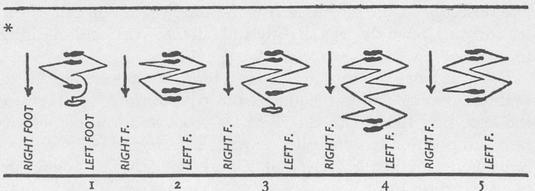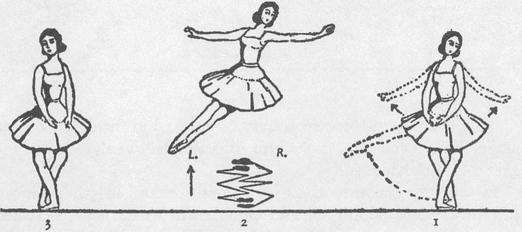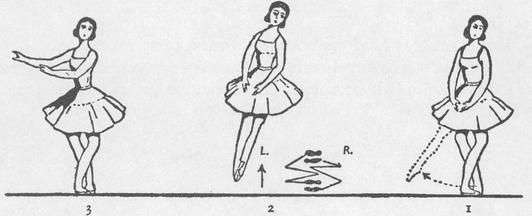Basic Principles of Classical Ballet (20 page)
Read Basic Principles of Classical Ballet Online
Authors: Agrippina Vaganova

Cabriole fermée differs from the described one in that the leg does not remain open, but closes in 5th position. The right leg must finish the movement in the same tempo as the left one, in demi-plié in 5th position.
If cabriole is done forward, the body bends back. Cabriole in the 3rd and 4th arabesques is comfortably done from the same preparation, but the body should be bent more forward—a position which is customary for these arabesques. If cabriole is done in 2nd position or in écarté with the right leg, the preparation should be croisé back with the left leg; at the concluding movement in plié, the body should be forcefully bent to the left. This must be done carefully so as to preserve the correct and beautiful pose. The arms, in all cases, assume the position required by the pose.
For cabrioles in 1st and 2nd arabesques the preparation should be taken from a small sissonne tombée in the direction of the movement.
Cabriole is one of the most difficult forms of the jump. At the beginning of its study one may use the following approach: open right leg in effacé, front at 45°, plié on left foot, and with a jump throw left leg to the right one, hitting the calf, lower yourself on left foot in demi-plié. Cabriole back is done the same way.
In the male dance, cabriole is done double, i.e. the calves of the legs hit each other twice. Very strong dancers may hit even more times. Attention must be paid, however, that the legs open well each time, otherwise the brilliant virtuosity this difficult pas presupposes will be lost.
In general, the study of high cabriole should begin after the difficulties of the other jumps have been overcome. Cabriole is the most difficult and the most complicated jump, requiring a well-developed elevation and ballon.
VIII
BEATS
BEATS, THE general French term for which is
batterie,
are steps in which one leg is beaten against the other. Beats bring into ballet the element of brilliance, virtuosity, and therefore the execution of them does not allow any carelessness, approximation or simplification, or they would lose their raison d’être. In the practice of beats one must adhere to the following rules necessary for a sharp and brilliant beat. During the beat both legs must be equally well extended, one should never beat with one leg while the other is in a passive state. Before each beat one must not forget to open the legs slightly, so as to get a sharp and clear-cut beat. In this manner, when a beat is done from the 5th position at the beginning of the jump, the legs must be slightly opened to the sides. If you don’t follow this rule, you’ll get a fuzzy smear which will look more like an obstruction to the dance than a virtuoso pas.
If a beat is done with legs opened in advance, i.e. not from 5th position, the legs must again slightly open after the beat and only then assume the required terminating pose.
Beats should not be simplified but, on the contrary, practised in their most complex form. For instance, small beats like royal, entrechat-trois, -quatre, -cinq, should be done close to the floor; this will force you to cross the legs very quickly with a short, sharp movement. This is much more difficult, but there is more compactness, energy, and brilliance in such beats. If these small beats are done during a big jump, high in the air, you have enough time to do the beats, but the performance loses in brilliance.
There are three classifications of beats: pas battus, entrechats, and brisés.
PAS BATTUS
Any step embellished with a beat is called pas battu. When the pupils begin to do the more difficult pas allegro, these pas can be done with a beat; for example, saut de basque, which is very difficult, jeté en tournant with a beat, which is usually done by men, etc. Let us analyse a few examples.
To do assemblé with a beat from the right foot, we proceed as follows: if we open the right leg from the 5th position to the side, then on the return to the 5th position the right leg beats the left leg in front, opens again slightly in order to finish in the 5th position back. In order not to get a smear, it must be remembered that the legs beat with the calves, and that the leg should be opened before bringing it into 5th position.
Jeté with a beat from the right foot is done thus: the right leg thrust into 2nd position beats the left one in front, on the return it manages to open slightly, before you fall on it in demi-plié.
Small échappé with a beat from the right foot: after plié in 2nd position, on the return, beat with both legs calf on calf, right leg forward, open the legs slightly and fall into 5th position, right foot back.
Échappé battu can be done also in a more complicated manner: at the beginning during the jump from 5th position slightly open the legs, beat them with the right leg front and lower yourself into 2nd position in demi-plié; on the return to the 5th position, beat again with the right leg front, slightly open the legs and finish in 5th position back.
This échappé can be further elaborated thus: before opening the legs into 2nd position, do a beat the type of entrechat-quatre, and repeat it on the return from 2nd position into 5th position. In this kind of échappé one must do a high jump, almost like the one for a big échappé, although, in general, I recommend for entrechat-quatre a low jump. But the movements described are more complicated, and they demand more time, hence one could not make them during a low jump.
All these beats are done in this manner when moving backward; going forward, they are done the opposite way, i.e. the leg beats to the back and the final position is in front.
It is easier to begin the study of beats with échappé, and then work on assemble and jeté.
ENTRECHATS
ROYAL
Stand in 5th position, right foot front; demi-plié, small jump, open both legs slightly; with the right leg in front, beat the calf of the left leg against the calf of the right leg, slightly open the legs to the side, and the right leg goes back into 5th position in demi-plié.
ENTRECHAT-QUATRE
5th position, right foot front; demi-plié, small jump, open the legs slightly and beat the calf of the left leg against the calf of the right leg which is at the back, slightly open legs to the sides and finish with right foot front in 5th position in demi-plié.
Entrechat-quatre is called thus, because the leg moves as if going through four lengths of a broken line: (1) opening, (z) beat back, (3) opening, (4) closing into 5th position front.
I repeat again, that the entire brilliance of this pas, its entire meaning, is to do it as close to the floor as possible, sharply opening and crossing the legs. It must be felt that the beat is done with both legs.

88. 1—Entrechat-trois, 2—entrechat-quatre, 3—entrechat-cinq, 4—entrechat-six, 5—royal
25
ENTRECHAT-SIX
5th position, right foot front; demi-plié, jump, during which open the legs, right leg beats back, open the legs to the sides, right leg beats front, open legs, and finish in 5th position right foot back.
This jump is done slightly higher. But even here one should not jump too high because during a high jump anybody will have time to do all the crossings. The brilliance of the performance can be shown only in a small jump, as this pas demands a great sharpness and speed.
ENTRECHAT-HUIT
Another opening and closing is added; hence, the right leg finishes front.
ENTRECHAT-TROIS
5th position, right foot front; demi-plié, small jump, legs open, right leg beats front, slightly opens and bends sur le cou-de-pied back, demi-plié on left leg. This entrechat as all odd ones finishes on one leg.
ENTRECHAT-CINQ
5th position, right foot front, demi-plié, small jump, during which the legs open, right leg beats back, legs open, right leg joins left one in front, and fall on right foot in demi-plié, left leg sur le cou-de-pied back.
ENTRECHAT-SEPT
5th position, right foot front; demi-plié, jump, open legs, right leg beats back, open legs, right leg beats front, open legs, legs join in the air (right one back), stop on right foot in demi-plié, left leg is in the air, or sur le cou-de-pied front, or in 2nd position at 45° or 90°, depending on how it was ordered. Entrechat-trois and entrechat-cinq may also be finished in various poses.
Entrechat-trois and entrechat-cinq we finish with the leg sur le cou-de-pied back. They may be done also to finish with the leg sur le cou-de-pied front. To do this, if the right leg was in front at the beginning, the legs open after the small jump, left leg beats on the calf back, slightly opens and is transferred front sur le cou-de-pied.
Entrechat-sept may be finished also in a different pose: front in effacé or croisé, or back in arabesque or attitude.
ENTRECHAT DE VOLÉE
Entrechat may be done not only from a jump on the spot, but also in a flight into any direction. The most convenient way to do it is from a glissade or coupé, but it may be practised also from 5th position.

89. Entrechat de volée
Entrechat-six de volée.
5th position, right foot front; demi-plié, left leg is thrust out to 90° to the side to 2nd position, jump, and you transfer with the entire body to that leg, doing meanwhile the necessary beats for entrechat-six. Finish in 5th position demi-plié, left foot front.
Entrechat-huit de volée
is done the same way, except that the number of beats is respectively greater.
The corresponding position of the arms and turn of the head is used as in croisé. If the foot is sur le cou-de-pied, the arms are not high, one at 45° in 1st position, the other at the same height in 2nd position; if the leg is in the air at 90°, the arms acquire a pose as in attitude, arabesque, or forward, or in 2nd position at 90°, then one arm will be in 3rd position, the other—in 2nd position, depending on the required pose.
BRISÉ
There are two kinds of brisé: (1) those that end in 5th position, and (2) those that end on one foot dessus or dessous.
1. In order to begin the movement with the right foot, stand in 5th position, left foot front; demi-plié, right leg is thrust into the air with a gliding movement to the side, between points 2 and 3, then it beats front on left calf while left leg, with a jump, flies together with the entire body to the spot where the toe of right foot was when it was thrust out. Open legs and finish in 5th position, right leg back in demi-plié.

90. Brisé
This movement forward is very often used in the dance on the stage. Brisé back is used seldom, but we shall analyse it for the sake of completeness.
In order to move to the opposite side, stand in 5th position, left foot front; demi-plié, and slide it out to the side, between points 6 and 7; left leg beats the right calf back; with a jump travel in the same direction into which left leg moved, open legs and finish with left leg front in demi-plié, paying attention that the left leg is well turned out.
